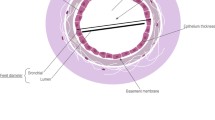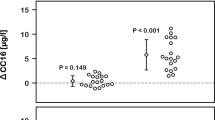Abstract
Male Fischer 344 rats were exposed to 0.5 ppm ozone for 20 hr/day, 7 days/week, for 52 weeks after which they were allowed to recover in clean filtered air for 12 weeks. Pulmonary function testing, which included measurements of lung volumes, expiratory air flows, and DLco, was performed before the initiation of exposure, after 26 and 52 weeks of exposure, and after the 12 week recovery. Control animals were tested at the same times but exposed only to clean filtered air. Another group, periodically sacrificed for histopathologic evaluation, was similarly exposed to ozone but allowed to recover in clean air for 24 weeks. The 52 weeks of ozone exposure produced small but statistically significant changes in several of the functional measurements when compared to clean air controls (FRC + 7.0%; RV + 11.2%; DLco - 7.3%). These measurements returned to control levels with 3 months of recovery. All other parameters showed no significantly different values between the 2 groups throughout the exposure and recovery periods. After both 6 and 12 months of ozone exposure, microscopic evaluation revealed a slight inflammatory response in the alveolar duct walls and septa of the immediately adjacent alveoli. This response included the accumulation of mononuclear cells and fibroblasts, thickening of alveolar septa, and a slight increase in macrophage population. With 6 months of recovery, the inflammation had all but disappeared. There remained only a slight dilation and thickening of an occasional alveolar duct and its adjacent alveoli. We conclude that the functional changes seen in the lungs in response to the ozone insult were the result of the observed inflammation in the distal areas of the lung, and the lesions produced were reversible to the extent that they could not be detected functionally after recovery.
Similar content being viewed by others
References
Boorman GA, Schwartz LW, Dungworth DL (1980) Pulmonary effects of prolonged ozone insult in rats. Morphometric evaluation of the central acinus. Lab Invest 43:108–115
Cavender FL, Singh B, Cockrell BY (1978) Effects in rats and guinea pigs of six month exposures to sulfuric acid mist, ozone, and their combination. J Toxicol Environ Health 9:845–852
Costa DL, Kutzman RS, Lehmann JR, Popenoe EA, Drew RT (1983) A subchronic multidose ozone study in rats. In: Lee SD, Mustafa MA, Mehlman MA (eds) Advances in modern environmental toxicology, vol 5. International symposium on the biomedical effects of ozone and related photochemical oxidants. Princeton Scientific Publishers, Princeton, pp 369–392
Eustis SL, Schwartz LW, Kosch PC, Dungworth DL (1981) Chronic bronchiolitis in non-human primates after prolonged ozone exposure. Am J Pathol 105:121–137
Duncan DB (1955) Multiple range and multiple F tests. Biometrics 11:1–42
Dungworth DL, Castlemem WL, Chow CK, Mellick PW, Mustafa MG, Tarkington B, Tyler WS (1975) Effect of ambient levels of ozone on monkeys. Fed Proc 34:1670–1674
Evans MJ, Dekker NP, Cabral-Anderson LJ, Shami SG (1985) Morphological basis of tolerance to ozone. Exp Mol Pathol 42:366–376
Folinsbee LJ, Horvath SW, Raven PB, Bedi JF, Morton AR, Drinkwater BL, Bolduan NW, Gliner JA (1977) Influence of exercise and heat stress on pulmonary function during ozone exposure. J Appl Physiol 43:409–413
Freeman G, Crane SC, Furiosi NJ, Stephans RL, Evans MJ, Moore WD (1972) Covert reduction in ventilatory surface in rats during prolonged exposure to subacute nitrogen dioxide. Am Rev Respir Dis 106:563–579
Freeman G, Juhos LT, Furiosi NJ, Mussenden R, Stephensn RJ, Evans MJ (1974) Pathology of pulmonary disease from exposure to interdependent ambient gases (nitrogen dioxide and ozone). Arch Environ Health 29:203–210
Fujinaka LE, Hyde DM, Plopper CG, Tyler WS, Dungworth DL, Lollini LO (1985) Respiratory bronchiolitis following long-term ozone exposure in bonnet monkeys: a morphometric study. Exp Lung Res 8:167–190
Gross KB, White HJ, Smiler KL (1984) Functional and morphological changes in the lungs after a single intratracheal instillation of silica. Am Rev Respir Dis 129:833–839
Gross KB, White HJ (1986) Pulmonary functional and morphological changes induced by a four-week exposure to 0.7 ppm ozone followed by a nine-week recovery period. J Toxicol Environ Health 17:143–157
Kapanci Y, Weibel ER, Kaplan HP, Robinson FR (1969) Pathogenesis and reversibility of the pulmonary lesions of oxygen toxicity in monkeys. II. Ultrastructural and morphometric studies. Lab Invest 20:101–118
Lam C, Kattan M, Collins A, Kleinerman J (1983) Long-term sequelae of bronchiolitis by nitrogen dioxide in hamsters. Am Rev Respir Dis 128:1020–1023
Last JA, Reiser KM, Tyler WS, Rucker RB (1984) Long-term consequences of exposure to ozone. Toxicol Appl Pharmacol 72:111–118
Mautz WJ, McClure TR, Reischi P, Phalen RF, Crocker TT (1985) Enhancement of ozone-induced lung injury by exercise. J Toxicol Environ Health 16:841–854
McDonnell WF, Hostman DH, Hazucha MJ, Seal E Jr, Haak ED, Salaam SA, House DE (1983) Pulmonary effects of ozone exposure during exercise: dose-response characteristics. J Appl Physiol 54:1345–1352
Mellick PW, Dungworth DL, Schwartz LW, Tyler WS (1977) Short term morphologic effects of high ambient levels of ozone on lungs of rhesus monkeys. Lab Invest 36:82–90
Moore PF, Schwartz LW (1981) Morphological effects of prolonged exposure to ozone and sulfuric acid aerosol on the rat lung. Exp Mol Pathol 35:108–123
Raghu G, Striker L, Harlan J, Gown A, Striker G (1986) Cytoskeletal changes as an early event in hydrogen peroxide-induced cell injury: a study in A459 cells. Br J Exp Pathol 67:105–112
Riley DJ, Kerr JS (1985) Oxidant injury of the extracellular matrix: potential role in the pathogenesis of pulmonary emphysema. Lung 163:1–13
Scheel LD, Dobrogorski OJ, Mountain JT, Svirbeley JL, Stokinger HE (1959) Physiologic, biochemical, immunologic and pathologic changes following ozone exposure. J Appl Physiol 14:67–80
Schwartz LW, Dungworth DL, Mustafa MG, Tarkington BK, Tyler WS (1976) Pulmonary response of rats to ambient levels of ozone: effects of 7-day intermittent or continuous exposure. Lab Invest 34:565–578
Silverman F, Folinsbee LJ, Barnard J, Shephard RJ (1976) Pulmonary function changes in ozone—interaction of concentration and ventilation. J Appl Physiol 41:859–864
Taylor AE, Martin DJ, Townsley MI (1985) Oxygen and pulmonary edema. In: Said SI (ed) The pulmonary circulation and acute lung injury. Futura Publishing, Mount Kisco, NY, pp 307–320
Author information
Authors and Affiliations
Additional information
This work was presented in part at the Annual Meeting of the American Thoracic Society, Anaheim, California, May, 1985.
This research was conducted at the General Motors Research Laboratories in facilities fully accredited by the American Association of Laboratory Animal Care.
Rights and permissions
About this article
Cite this article
Gross, K.B., White, H.J. Functional and pathologic consequences of a 52-week exposure to 0.5 PPM ozone followed by a clean air recovery period. Lung 165, 283–295 (1987). https://doi.org/10.1007/BF02714445
Accepted:
Issue Date:
DOI: https://doi.org/10.1007/BF02714445




